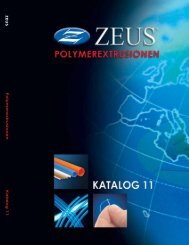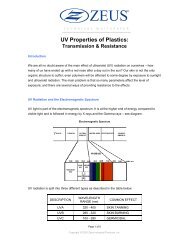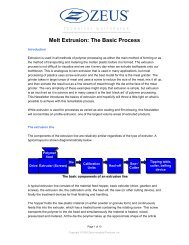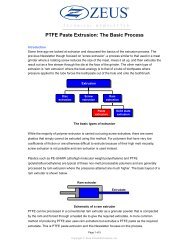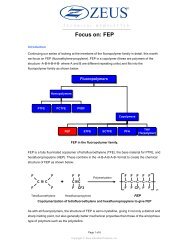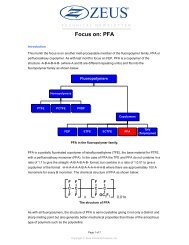Crystallinity in Plastics - Zeus Industrial Products, Inc.
Crystallinity in Plastics - Zeus Industrial Products, Inc.
Crystallinity in Plastics - Zeus Industrial Products, Inc.
You also want an ePaper? Increase the reach of your titles
YUMPU automatically turns print PDFs into web optimized ePapers that Google loves.
Introduction<br />
TECHNICAL NEWSLETTER<br />
<strong>Crystall<strong>in</strong>ity</strong> <strong>in</strong> <strong>Plastics</strong><br />
In previous Technical Newsletters, we mentioned the effect of crystall<strong>in</strong>ity <strong>in</strong> plastics but never<br />
delved deeper <strong>in</strong>to this topic. This Technical Newsletter will more closely consider crystall<strong>in</strong>ity<br />
<strong>in</strong> plastics: what it is, and more importantly, how it affects the properties of plastics.<br />
Most people are familiar with crystals only because of salt and perhaps grow<strong>in</strong>g crystals as<br />
part of a school science project. Therefore, talk<strong>in</strong>g about crystals and plastics together is a<br />
new concept to many people. In reality, polymers are not like salt, which is totally crystall<strong>in</strong>e,<br />
but are semi-crystall<strong>in</strong>e. Unlike crystals like salt, polymers have only short-range order and a<br />
much looser organization.<br />
<strong>Crystall<strong>in</strong>ity</strong> is one of the great divisions of the complete family of plastics. Amorphous<br />
polymers (those with no significant degree of crystallization) behave very differently than<br />
crystall<strong>in</strong>e polymers (those with a significant degree of crystallization). Understand<strong>in</strong>g<br />
crystallization and the effect it has on the properties of polymers can make understand<strong>in</strong>g the<br />
behavior of polymer families much easier.<br />
Amorphous and crystall<strong>in</strong>e polymers:<br />
Amorphous polymers<br />
Amorphous polymers are those where the polymer cha<strong>in</strong>s have no well-def<strong>in</strong>ed order <strong>in</strong> either<br />
the solid or liquid states. The model that is most often associated with this characterization is<br />
a bowl of cooked spaghetti, where the long strands of spaghetti are both flexible and slide<br />
over one another. This is similar to a molten amorphous polymer as it is be<strong>in</strong>g processed. If<br />
the hot spaghetti is tipped <strong>in</strong>to a bowl, then it will take the shape of the bowl, just as a plastic<br />
does when it fills a mold. After the spaghetti has cooled, the long strands tend to stick to one<br />
another, which is very similar to the behavior of an amorphous polymer after it has cooled.<br />
The classic two-dimensional representation of an amorphous polymer is shown below:<br />
Page 1 of 9<br />
Copyright ©2007-2010 <strong>Zeus</strong> <strong>Industrial</strong> <strong>Products</strong>, <strong>Inc</strong>.
Amorphous polymer - random molecular orientation <strong>in</strong> both molten and solid<br />
phases<br />
Examples of amorphous polymer are PMMA, PS, PVC and ABS. As a rule, any polymer that<br />
can be produced <strong>in</strong> a transparent form is an amorphous polymer.<br />
Crystall<strong>in</strong>e polymers<br />
In the molten phase, crystall<strong>in</strong>e polymers closely resemble amorphous polymers. However,<br />
the real difference between the two exhibits itself dur<strong>in</strong>g cool<strong>in</strong>g. As crystall<strong>in</strong>e polymers cool,<br />
small areas of short-range order form. These are highly organized and closely packed areas<br />
of polymer molecules and are recognized as the “polymer crystals” <strong>in</strong> crystall<strong>in</strong>e polymers.<br />
However, they are not at all like the crystals <strong>in</strong> salt or other <strong>in</strong>organic materials. There are<br />
several models and theories regard<strong>in</strong>g crystal formation, but the most popular is the “fr<strong>in</strong>ged<br />
micelle” model. Shown below is a two-dimensional representation of molecules <strong>in</strong> a crystall<strong>in</strong>e<br />
polymer accord<strong>in</strong>g to the fr<strong>in</strong>ged micelle theory. It shows the ordered regions or crystallites (<strong>in</strong><br />
red) embedded <strong>in</strong> an amorphous matrix.<br />
Crystall<strong>in</strong>e polymer - random molecular orientation <strong>in</strong> molten phase but densely<br />
packed crystallites <strong>in</strong> solid phase<br />
The red ordered regions show above are made up of polymer cha<strong>in</strong>s that are folded <strong>in</strong>to<br />
highly ordered regions as shown <strong>in</strong> the figure below.<br />
Page 2 of 9<br />
Copyright ©2007-2010 <strong>Zeus</strong> <strong>Industrial</strong> <strong>Products</strong>, <strong>Inc</strong>.
Folded lamellae crystals <strong>in</strong> a crystall<strong>in</strong>e polymer, color coded for clarity.<br />
A s<strong>in</strong>gle polymer backbone cha<strong>in</strong> may be present <strong>in</strong> sections of different crystallites, which<br />
are generally small and separated by areas without a short-range order. Larger structures,<br />
made up of bundles of crystallites, are termed spherulites and these are formed <strong>in</strong> the bulk of<br />
the material. These are formed and grow <strong>in</strong> a similar manner to the formation and growth of<br />
gra<strong>in</strong>s <strong>in</strong> a metal.<br />
Spherulites <strong>in</strong> poly-3-hydroxy butyrate (PHB)<br />
Source: Prof T. W. Clyne, Department of Materials Science and Metallurgy,<br />
University of Cambridge, UK. Used with permission.<br />
This image (with full documentation) is available at<br />
www.msm.cam.ac.uk/doitpoms/miclib<br />
Crystal formation beg<strong>in</strong>s at nucleation po<strong>in</strong>ts and extends outwards <strong>in</strong>to the bulk of the<br />
polymer. The nucleation itself can be one of the follow<strong>in</strong>g:<br />
� Homogeneous - this is the case for a pure polymer, e.g. virg<strong>in</strong> PP and the result is a<br />
small number nucleation sites and a few large crystals as seen <strong>in</strong> the figure above.<br />
� Heterogeneous - where particles <strong>in</strong> the polymer (natural or added deliberately) act as<br />
nucleation sites and many small crystals are formed. This is the case for PP with<br />
certa<strong>in</strong> color<strong>in</strong>g agents and results <strong>in</strong> higher shr<strong>in</strong>kage rates.<br />
The type of nucleation process will also affect the properties of crystall<strong>in</strong>e polymers. A product<br />
with relatively few large crystals will have different properties than one with more, but smaller,<br />
crystals.<br />
Page 3 of 9<br />
Copyright ©2007-2010 <strong>Zeus</strong> <strong>Industrial</strong> <strong>Products</strong>, <strong>Inc</strong>.
Examples of crystall<strong>in</strong>e polymers are PP, PE (all varieties but some more so than others), PA<br />
and POM. As a rule, any polymer that is translucent or opaque <strong>in</strong> the natural form is a<br />
crystall<strong>in</strong>e polymer.<br />
The degree of crystall<strong>in</strong>ity<br />
Not all polymers crystallize to the same degree. All polymers have some degree of<br />
crystall<strong>in</strong>ity except for amorphous polymers. <strong>Crystall<strong>in</strong>ity</strong> can vary between 0% (an<br />
amorphous polymer) and 80% (a highly crystall<strong>in</strong>e polymer).<br />
There are also a number of variables present <strong>in</strong> polymer structure that affect crystall<strong>in</strong>ity, and<br />
they are:<br />
� Polymer cha<strong>in</strong> length: Molecular weight is a measure of how long the polymer<br />
backbone cha<strong>in</strong> is. If the molecular weight is high, then the polymer backbone cha<strong>in</strong><br />
is long and the degree of crystall<strong>in</strong>ity is reduced. This is illustrated by the behavior of<br />
PE. HDPE molecules are up to 100 times longer than LDPE molecules. As a result,<br />
the degree of crystall<strong>in</strong>ity of HDPE is much lower than LDPE.<br />
� Stereoregularity: This is a measure of how the mers (the repeat units <strong>in</strong> the polymer)<br />
are arranged <strong>in</strong> the polymer backbone cha<strong>in</strong>. Isotactic materials have the mers<br />
connected together <strong>in</strong> a s<strong>in</strong>gle repeated manner, syndiotactic materials have the<br />
mers connected together <strong>in</strong> a regularly repeated but different manner, and atatic<br />
materials have the mers connected together <strong>in</strong> a random manner. Atactic materials<br />
are generally amorphous because of the lack of polymer cha<strong>in</strong> order, whereas<br />
isotactic and syndiotactic polymers are typically crystall<strong>in</strong>e because of the high<br />
degree of polymer cha<strong>in</strong> regularity. This effect can be used to <strong>in</strong>crease the properties<br />
of some polymer, such as PP, by encourag<strong>in</strong>g crystallization through the use of<br />
stereospecific forms of the material.<br />
� Polar groups: Some polymers have polar groups present along the ma<strong>in</strong> polymer<br />
cha<strong>in</strong>, e.g. the CO group is present <strong>in</strong> many amorphous polymers. These groups<br />
repel each another and prevent the formation of crystall<strong>in</strong>e structures. Equally, some<br />
materials, such as the polyamides, form crystals very easily because of the attraction<br />
between sections of the ma<strong>in</strong> backbone cha<strong>in</strong>.<br />
� Cha<strong>in</strong> branch<strong>in</strong>g: The degree of branch<strong>in</strong>g on the ma<strong>in</strong> backbone cha<strong>in</strong> will affect the<br />
ability to crystallize. Highly branched polymers will generally be less crystall<strong>in</strong>e than<br />
l<strong>in</strong>ear polymers due to the presence of long branches.<br />
The rate of crystallization<br />
The rate of crystallization is dependent on temperature, of which there are two significant<br />
po<strong>in</strong>ts:<br />
� Tg - The glass transition temperature. Below Tg, there is virtually no molecular motion<br />
on a local scale. Polymers have many of the properties associated with ord<strong>in</strong>ary<br />
organic glasses <strong>in</strong>clud<strong>in</strong>g hardness and stiffness.<br />
Page 4 of 9<br />
Copyright ©2007-2010 <strong>Zeus</strong> <strong>Industrial</strong> <strong>Products</strong>, <strong>Inc</strong>.
� Tm - The crystall<strong>in</strong>e melt<strong>in</strong>g po<strong>in</strong>t. This is the temperature at which crystals melt and<br />
a crystall<strong>in</strong>e polymer resembles an amorphous polymer, which has no short-range<br />
order. Tm generally <strong>in</strong>creases as the degree of crystall<strong>in</strong>ity <strong>in</strong>creases.<br />
The rate of crystallization (both nucleation and growth) depends on temperature, as shown<br />
below:<br />
Rate of crystallization<br />
Maximum rate of<br />
crystallization at<br />
T = (T g + T m )/2<br />
T g<br />
Temperature<br />
Typical form of crystallization rate-temperature curve for a crystall<strong>in</strong>e l<strong>in</strong>ear<br />
polymer<br />
Above Tm, no crystallization exists and below Tg, no further movement of molecules is<br />
possible to nucleate or grow crystals. The fastest rate of crystallization occurs midway<br />
between Tg and Tm. The longer a polymer rema<strong>in</strong>s between the two, the greater the amount<br />
of crystallization. For example:<br />
� For PP, Tg is -10 to -20ºC and Tm is 150 to 175ºC – PP will therefore cont<strong>in</strong>ue to<br />
crystallize slowly at room temperature (21ºC) until equilibrium is reached.<br />
� For PTFE, Tg is -110ºC and Tm 330ºC – PTFE crystallizes rapidly at room<br />
temperature (21ºC).<br />
The properties of amorphous and crystall<strong>in</strong>e polymers:<br />
General properties<br />
The general properties of amorphous and crystall<strong>in</strong>e polymers are shown below:<br />
GENERAL PROPERTIES<br />
AMORPHOUS PLASTICS SEMI-CRYSTALLINE PLASTICS<br />
� Soften over a wide range of temperatures � Dist<strong>in</strong>ct and sharp melt<strong>in</strong>g po<strong>in</strong>t<br />
� Lower specific gravity<br />
� Higher specific gravity due to better<br />
� Lower tensile strength and tensile<br />
pack<strong>in</strong>g<br />
modulus<br />
� Higher tensile strength and tensile<br />
� Higher ductility and impact strength<br />
modulus<br />
� Lower creep resistance<br />
� Lower ductility and impact strength<br />
Page 5 of 9<br />
Copyright ©2007-2010 <strong>Zeus</strong> <strong>Industrial</strong> <strong>Products</strong>, <strong>Inc</strong>.<br />
T m
� Tend to be transparent<br />
� Higher creep resistance<br />
� Higher dimensional stability<br />
� Tend to be translucent or opaque<br />
� Lower fatigue resistance<br />
� Lower dimensional stability<br />
� Bond well us<strong>in</strong>g adhesives and solvents � Higher fatigue resistance<br />
� Lower chemical resistance and resistance � Difficult to bond us<strong>in</strong>g adhesives and<br />
to stress crack<strong>in</strong>g<br />
solvents<br />
� Structural applications only (not for � Higher chemical resistance and resistance<br />
bear<strong>in</strong>g and wear)<br />
to stress crack<strong>in</strong>g<br />
� Good for bear<strong>in</strong>g and wear, as well as for<br />
structural applications<br />
The general properties of amorphous and crystall<strong>in</strong>e polymers<br />
Simply know<strong>in</strong>g if a polymer is amorphous or crystall<strong>in</strong>e will help def<strong>in</strong>e its behavior and many<br />
of its properties. The Periodic Table of Thermoplastics (developed by Tangram Technology<br />
Ltd.) depicts how the dist<strong>in</strong>ction between amorphous and crystall<strong>in</strong>e polymers represents one<br />
of the fundamental divisions <strong>in</strong> the thermoplastics family. It is shown on the follow<strong>in</strong>g page.<br />
Page 6 of 9<br />
Copyright ©2007-2010 <strong>Zeus</strong> <strong>Industrial</strong> <strong>Products</strong>, <strong>Inc</strong>.
Amorphous and crystall<strong>in</strong>e plastics<br />
Adapted from “The Periodic Table of Thermoplastics”<br />
Tangram Technology Ltd. (www.tangram.co.uk)<br />
Page 7 of 9<br />
Copyright ©2007-2010 <strong>Zeus</strong> <strong>Industrial</strong> <strong>Products</strong>, <strong>Inc</strong>.
Melt<strong>in</strong>g behavior<br />
Crystall<strong>in</strong>e polymers have dist<strong>in</strong>ct melt<strong>in</strong>g po<strong>in</strong>ts (Tm). At this po<strong>in</strong>t, the crystall<strong>in</strong>e regions<br />
break up and short-range order is lost. However, <strong>in</strong> amorphous polymers, regions tend to<br />
soften over a wide temperature range.<br />
Shr<strong>in</strong>kage 1<br />
Shr<strong>in</strong>kage of plastics products after process<strong>in</strong>g is common, but crystall<strong>in</strong>e and amorphous<br />
polymers shr<strong>in</strong>k differently. All plastics parts shr<strong>in</strong>k after process<strong>in</strong>g simply as a result of their<br />
compressibility and the thermal contraction as they cool from the process<strong>in</strong>g temperature.<br />
With amorphous plastics, this is the only factor and is easily calculated. But because<br />
crystallites conta<strong>in</strong> more ordered and better pack<strong>in</strong>g of the polymer cha<strong>in</strong>s, phase transition<br />
<strong>in</strong>creases shr<strong>in</strong>kage considerably.<br />
For amorphous polymers, shr<strong>in</strong>kage values are not only low, but shr<strong>in</strong>kage itself is quick to<br />
occur. For a typical amorphous polymer such as PMMA, the shr<strong>in</strong>kage will be <strong>in</strong> the order of<br />
0.001 - 0.005 m/m. This is due to cool<strong>in</strong>g from about 150ºC (the temperature of the melt) to<br />
23ºC (room temperature) and can be related to the co-efficient of thermal expansion.<br />
Shr<strong>in</strong>kage is 90-95% complete immediately after process<strong>in</strong>g and 100% complete with<strong>in</strong> 3 to 4<br />
hours 2 .<br />
Crystall<strong>in</strong>e polymers are not only affected by compressibility and temperature shr<strong>in</strong>kage but<br />
also by crystallization shr<strong>in</strong>kage. As the polymer solidifies, crystals form and the improved<br />
pack<strong>in</strong>g leads to shr<strong>in</strong>kage values far greater than those seen <strong>in</strong> amorphous polymers. For a<br />
typical crystall<strong>in</strong>e polymer such as PP, shr<strong>in</strong>kage will be <strong>in</strong> the order of 0.01 - 0.025 m/m. This<br />
is between 5 to 10 times the shr<strong>in</strong>kage of an amorphous polymer. Only about 85% of this<br />
higher shr<strong>in</strong>kage will have taken place <strong>in</strong> the first 24 hours, about 98-99% will have taken<br />
place <strong>in</strong> the first week and the rema<strong>in</strong><strong>in</strong>g shr<strong>in</strong>kage may take up to 3 months to complete.<br />
Generally, about 85% of shr<strong>in</strong>kage occurs <strong>in</strong> the first 24 hours and 98-99% has taken place <strong>in</strong><br />
the first week. The rema<strong>in</strong><strong>in</strong>g shr<strong>in</strong>kage may take up to 3 months to complete. In such cases,<br />
it is normal to anneal the molded article for a short time at the maximum crystallization<br />
temperature to force the polymer to equilibrium where full shr<strong>in</strong>kage can take place with<strong>in</strong> an<br />
hour.<br />
This variable shr<strong>in</strong>kage effect means that process<strong>in</strong>g tolerances achievable for amorphous<br />
polymers are far better than those for crystall<strong>in</strong>e polymers.<br />
1<br />
For a more complete discussion of shr<strong>in</strong>kage <strong>in</strong> plastics parts see: www.tangram.co.uk/TI-<br />
Polymer-Shr<strong>in</strong>kage_<strong>in</strong>_plastics.html<br />
2<br />
Other factors, such as part geometry, orientation and mold<strong>in</strong>g parameters have been<br />
ignored <strong>in</strong> this simple explanation.<br />
Page 8 of 9<br />
Copyright ©2007-2010 <strong>Zeus</strong> <strong>Industrial</strong> <strong>Products</strong>, <strong>Inc</strong>.
Controll<strong>in</strong>g crystall<strong>in</strong>ity<br />
<strong>Crystall<strong>in</strong>ity</strong> can be controlled, even <strong>in</strong> semi-crystall<strong>in</strong>e plastics by modify<strong>in</strong>g process<strong>in</strong>g<br />
techniques. It is possible to quench, or rapidly cool, plastic parts to reduce the formation of<br />
crystals. However, the success of this depends on the relationship of Tg (the glass transition<br />
temperature) of the polymer and the service temperature. If Tg is higher than the service<br />
temperature, then the quench<strong>in</strong>g will prevent the formation of crystals dur<strong>in</strong>g cool<strong>in</strong>g. As a<br />
result, they are unlikely to form dur<strong>in</strong>g the service life of the product. Equally, if the service<br />
temperature is approximately the same as or higher than Tg, then quench<strong>in</strong>g will only delay<br />
the <strong>in</strong>evitable, and crystallization and shr<strong>in</strong>kage will eventually occur down the road, possibly<br />
mak<strong>in</strong>g the product unfit for use.<br />
Equally, it is possible to anneal polymers after process<strong>in</strong>g to ensure that proper crystallization<br />
has taken place. Anneal<strong>in</strong>g <strong>in</strong>volves hold<strong>in</strong>g the polymer above Tg but below Tm for a specific<br />
time to both encourage and control the growth of the crystall<strong>in</strong>e structure.<br />
High nucleation and growth rates can also be achieved if heterogeneous nucleation is used.<br />
In this case, nucleation is <strong>in</strong>itiated by seed<strong>in</strong>g with a foreign particle, which is typically a<br />
polymer similar to the base polymer but with a higher melt<strong>in</strong>g po<strong>in</strong>t. Some commercial<br />
products <strong>in</strong>corporate special nucleat<strong>in</strong>g agents to produce a high degree of crystallization and<br />
controlled structures, <strong>in</strong>clud<strong>in</strong>g color<strong>in</strong>g agents.<br />
It is also possible to <strong>in</strong>duce directional crystallization by stretch<strong>in</strong>g polymers below Tm to<br />
create crystall<strong>in</strong>e filaments, fibers or sheets with a crystall<strong>in</strong>e structure oriented <strong>in</strong> the<br />
direction of stretch<strong>in</strong>g. This cold-draw<strong>in</strong>g technique is used extensively <strong>in</strong> fiber and film<br />
production to produce high strength fibers and films and <strong>in</strong> the production of PET bottles with<br />
<strong>in</strong>jection blow mold<strong>in</strong>g.<br />
Summary<br />
<strong>Crystall<strong>in</strong>ity</strong> <strong>in</strong> polymers is not a simple laboratory curiosity or topic of marg<strong>in</strong>al <strong>in</strong>terest. It is<br />
one of the fundamental divisions between polymer types and it both controls and affects many<br />
of the polymer process<strong>in</strong>g techniques that are <strong>in</strong> common use today. Understand<strong>in</strong>g<br />
crystallization is not difficult and once understood it provides a framework for understand<strong>in</strong>g<br />
many of the properties, processes and problems of modern plastics process<strong>in</strong>g.<br />
At <strong>Zeus</strong>, we deal with highly crystall<strong>in</strong>e materials every day. With over 40 years of experience<br />
work<strong>in</strong>g with products like PTFE, FEP, PFA, and PEEK, we have the expert scientists and<br />
technical design eng<strong>in</strong>eers able to meet your needs and address your concerns.<br />
Page 9 of 9<br />
Copyright ©2007-2010 <strong>Zeus</strong> <strong>Industrial</strong> <strong>Products</strong>, <strong>Inc</strong>.



